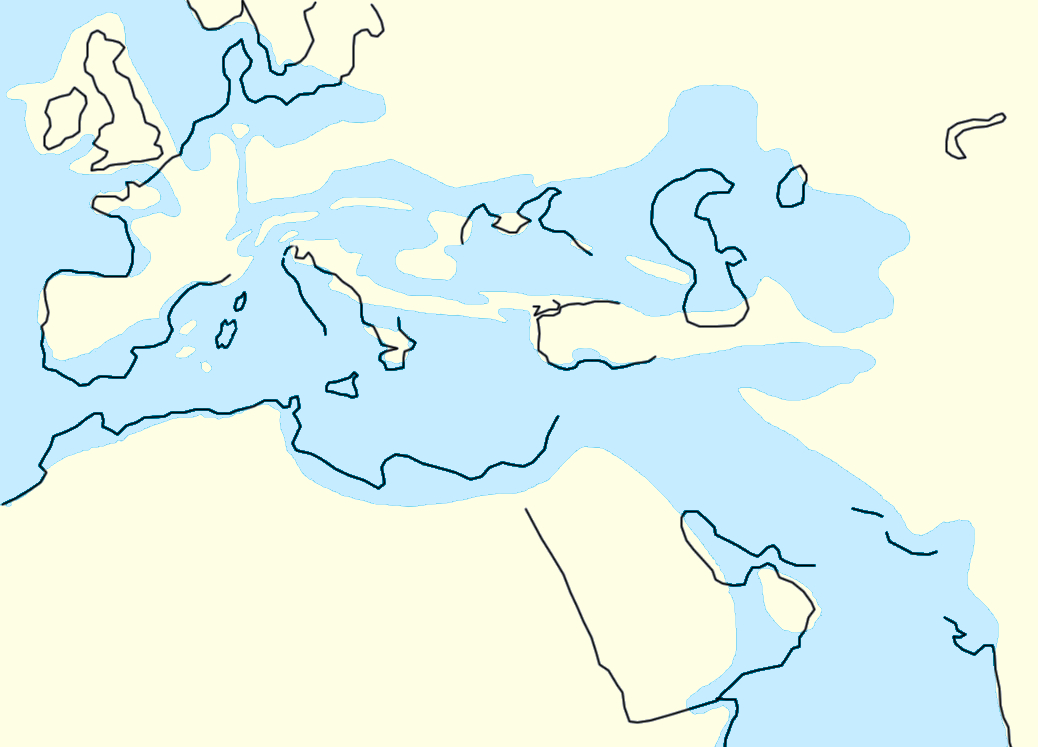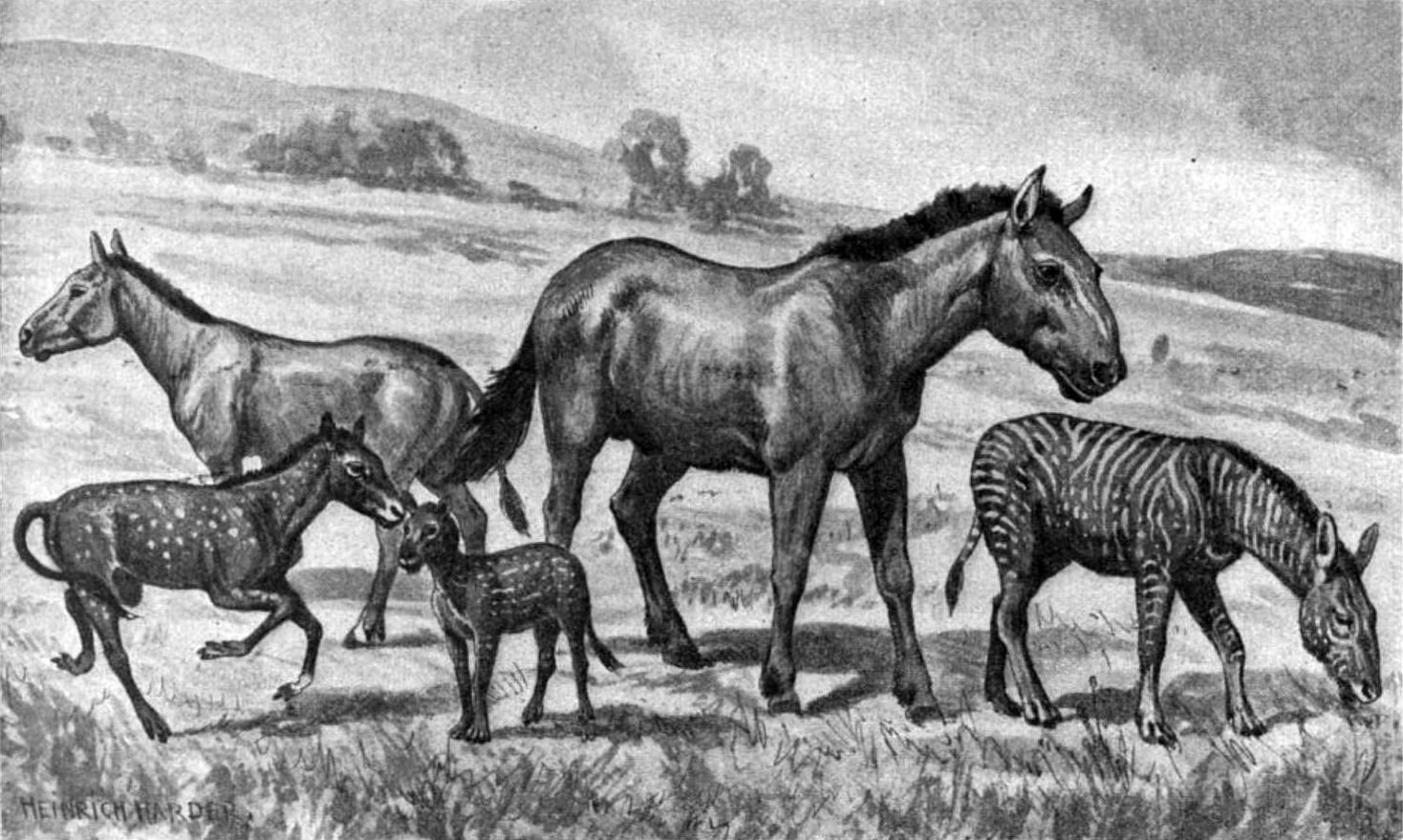|
Mesohippus
''Mesohippus'' (Greek: / meaning "middle" and / meaning "horse") is an extinct genus of early horse. It lived 37 to 32 million years ago in the Early Oligocene. Like many fossil horses, ''Mesohippus'' was common in North America. Its shoulder height is estimated about 60 cm tall. Description ''Mesohippus'' had longer legs than its predecessor '' Eohippus'' and stood about 60 cm (6 hands) tall. This equid is the first fully tridactyl horse in the evolutionary record, with the third digit being longer and larger than its second and fourth digits; ''Mesohippus'' had not developed a hoof at this point, rather it still had pads as seen in ''Hyracotherium'' and '' Orohippus''.MacFadden, B. J.. 1992. Fossil Horses: Systematics, Paleobiology, and Evolution of the Family Equidae. Cambridge University Press, Cambridge. The face of ''Mesohippus'' was longer and larger than earlier equids. It had a slight facial fossa, or depression, in the skull. The eyes were rounder, and were set wi ... [...More Info...] [...Related Items...] OR: [Wikipedia] [Google] [Baidu] |
Oligocene Horses
The Oligocene ( ) is a geologic epoch of the Paleogene Period and extends from about 33.9 million to 23 million years before the present ( to ). As with other older geologic periods, the rock beds that define the epoch are well identified but the exact dates of the start and end of the epoch are slightly uncertain. The name Oligocene was coined in 1854 by the German paleontologist Heinrich Ernst Beyrich from his studies of marine beds in Belgium and Germany. The name comes from the Ancient Greek (''olígos'', "few") and (''kainós'', "new"), and refers to the sparsity of extant forms of molluscs. The Oligocene is preceded by the Eocene Epoch and is followed by the Miocene Epoch. The Oligocene is the third and final epoch of the Paleogene Period. The Oligocene is often considered an important time of transition, a link between the archaic world of the tropical Eocene and the more modern ecosystems of the Miocene. Major changes during the Oligocene included a global expansion ... [...More Info...] [...Related Items...] OR: [Wikipedia] [Google] [Baidu] |
White River Fauna
The White River Fauna are fossil animals found in the White River Badlands of South Dakota, Wyoming, Colorado and Nebraska in the United States including Badlands National Park. The fossils have been found in the White River Formation, Chadron Formation, Brule Formation, and the Arikaree Formation. Animals from the White River Badlands date from the Eocene, Oligocene, the Miocene, and the Pliocene Epochs. List Genera include: See also * :White River Fauna Further reading * Rachel Benton, ''The White River Badlands: Geology and Paleontology'', Indiana University Press 2015 * William Berryman Scott William Berryman Scott (February 12, 1858 – March 29, 1947) was an American vertebrate paleontologist, authority on mammals, and principal author of the White River Oligocene monographs. He was a professor of geology and paleontology at P ..., ''A history of land mammals in the western hemisphere'', MacMillan Publishing Company, 1913 References Paleogene anim ... [...More Info...] [...Related Items...] OR: [Wikipedia] [Google] [Baidu] |
Equidae
Equidae (sometimes known as the horse family) is the taxonomic family of horses and related animals, including the extant horses, asses, and zebras, and many other species known only from fossils. All extant species are in the genus ''Equus'', which originated in North America. Equidae belongs to the order Perissodactyla, which includes the extant tapirs and rhinoceros, and several extinct families. The term equid refers to any member of this family, including any equine. Evolution The oldest known fossils assigned to Equidae were found in North America, and date from the early Eocene epoch, 54 million years ago. They were once assigned to the genus '' Hyracotherium'', but the type species of that genus is now regarded as a palaeothere. The other species have been split off into different genera. These early equids were fox-sized animals with three toes on the hind feet, and four on the front feet. They were herbivorous browsers on relatively soft plants, and already ... [...More Info...] [...Related Items...] OR: [Wikipedia] [Google] [Baidu] |
Protohippus
''Protohippus'' is an extinct three-toed genus of horse. It was roughly the size of a modern donkey. Fossil evidence suggests that it lived during the Late Miocene (Clarendonian to Hemphillian), from about 13.6 Ma to 5.3 Ma. Analysis of ''Protohippus'' skull and teeth suggests that it is most closely related to the genus '' Calippus''. Species include: * ''P. vetus'' * ''P. perditus'' * ''P. supremus'' (also ''P. simus'') * ''P. gidleyi'' See also * ''Eohippus'' * ''Mesohippus ''Mesohippus'' (Greek: / meaning "middle" and / meaning "horse") is an extinct genus of early horse. It lived 37 to 32 million years ago in the Early Oligocene. Like many fossil horses, ''Mesohippus'' was common in North America. Its shoulder hei ...'' References {{Taxonbar, from=Q3408120 Miocene horses Prehistoric placental genera Miocene mammals of North America Clarendonian Hemphillian Fossil taxa described in 1858 Taxa named by Joseph Leidy ... [...More Info...] [...Related Items...] OR: [Wikipedia] [Google] [Baidu] |
Eohippus
''Eohippus'' is an extinct genus of small equid ungulates. The only species is ''E. angustidens'', which was long considered a species of ''Hyracotherium''. Its remains have been identified in North America and date to the Early Eocene (Ypresian stage). Discovery In 1876, Othniel C. Marsh described a skeleton as ''Eohippus validus'', from el, ἠώς (, 'dawn') and (, 'horse'), meaning 'dawn horse'. Its similarities with fossils described by Richard Owen were formally pointed out in a 1932 paper by Clive Forster Cooper. ''E. validus'' was moved to the genus ''Hyracotherium'', which had priority as the name for the genus, with ''Eohippus'' becoming a junior synonym of that genus. ''Hyracotherium'' was recently found to be a paraphyletic group of species, and the genus now includes only ''H. leporinum''. ''E. validus'' was found to be identical to an earlier-named species, ''Orohippus angustidens'' Cope, 1875, and the resulting binomial is thus ''Eohippus angustidens''. D ... [...More Info...] [...Related Items...] OR: [Wikipedia] [Google] [Baidu] |
Hyracotherium
''Hyracotherium'' ( ; " hyrax-like beast") is an extinct genus of very small (about 60 cm in length) perissodactyl ungulates that was found in the London Clay formation. This small, fox-sized animal was once considered to be the earliest known member of Equidae before the type species, ''H. leporinum'', was reclassified as a palaeothere, a perissodactyl family basal to both horses and brontotheres. The remaining species are now thought to belong to different genera, such as '' Eohippus'', which had previously been synonymised with ''Hyracotherium''. Description ''Hyracotherium'' averaged 78 cm (2.5 feet) in length and weighed about 9 kg (20 pounds). It had a short face with eye sockets in the middle and a short diastema (the space between the front teeth and the cheek teeth). The skull was long, having 44 low-crowned teeth. Although it had low-crowned teeth, the beginnings of the characteristic horse-like ridges on the molars can be seen. ''Hyracotherium'' is be ... [...More Info...] [...Related Items...] OR: [Wikipedia] [Google] [Baidu] |
Prehistoric Placental Genera
Prehistory, also known as pre-literary history, is the period of human history between the use of the first stone tools by hominins 3.3 million years ago and the beginning of recorded history with the invention of writing systems. The use of symbols, marks, and images appears very early among humans, but the earliest known writing systems appeared 5000 years ago. It took thousands of years for writing systems to be widely adopted, with writing spreading to almost all cultures by the 19th century. The end of prehistory therefore came at very different times in different places, and the term is less often used in discussing societies where prehistory ended relatively recently. In the early Bronze Age, Sumer in Mesopotamia, the Indus Valley Civilisation, and ancient Egypt were the first civilizations to develop their own scripts and to keep historical records, with their neighbors following. Most other civilizations reached the end of prehistory during the following Iron Age. ... [...More Info...] [...Related Items...] OR: [Wikipedia] [Google] [Baidu] |
Transitional Fossils
A transitional fossil is any fossilized remains of a life form that exhibits traits common to both an ancestral group and its derived descendant group. This is especially important where the descendant group is sharply differentiated by gross anatomy and mode of living from the ancestral group. These fossils serve as a reminder that taxonomic divisions are human constructs that have been imposed in hindsight on a continuum of variation. Because of the incompleteness of the fossil record, there is usually no way to know exactly how close a transitional fossil is to the point of divergence. Therefore, it cannot be assumed that transitional fossils are direct ancestors of more recent groups, though they are frequently used as models for such ancestors. In 1859, when Charles Darwin's ''On the Origin of Species'' was first published, the fossil record was poorly known. Darwin described the perceived lack of transitional fossils as "the most obvious and gravest objection which can be ... [...More Info...] [...Related Items...] OR: [Wikipedia] [Google] [Baidu] |
Rupelian Genus Extinctions
The Rupelian is, in the geologic timescale, the older of two ages or the lower of two stages of the Oligocene Epoch/ Series. It spans the time between . It is preceded by the Priabonian Stage (part of the Eocene) and is followed by the Chattian Stage. Name The stage is named after the small river Rupel in Belgium, a tributary to the Scheldt. The Belgian Rupel Group derives its name from the same source. The name Rupelian was introduced in scientific literature by Belgian geologist André Hubert Dumont in 1850. The separation between the group and the stage was made in the second half of the 20th century, when stratigraphers saw the need to distinguish between lithostratigraphic and chronostratigraphic names. Stratigraphic definition The base of the Rupelian Stage (which is also the base of the Oligocene Series) is at the extinction of the foraminiferan genus ''Hantkenina''. An official GSSP for the base of the Rupelian has been assigned in 1992 ( Massignano, Italy). The tr ... [...More Info...] [...Related Items...] OR: [Wikipedia] [Google] [Baidu] |
Eocene Odd-toed Ungulates
The Eocene ( ) Epoch is a geological epoch that lasted from about 56 to 33.9 million years ago (mya). It is the second epoch of the Paleogene Period in the modern Cenozoic Era. The name ''Eocene'' comes from the Ancient Greek (''ēṓs'', "dawn") and (''kainós'', "new") and refers to the "dawn" of modern ('new') fauna that appeared during the epoch. The Eocene spans the time from the end of the Paleocene Epoch to the beginning of the Oligocene Epoch. The start of the Eocene is marked by a brief period in which the concentration of the carbon isotope 13C in the atmosphere was exceptionally low in comparison with the more common isotope 12C. The end is set at a major extinction event called the ''Grande Coupure'' (the "Great Break" in continuity) or the Eocene–Oligocene extinction event, which may be related to the impact of one or more large bolides in Siberia and in what is now Chesapeake Bay. As with other geologic periods, the strata that define the start and end of ... [...More Info...] [...Related Items...] OR: [Wikipedia] [Google] [Baidu] |








